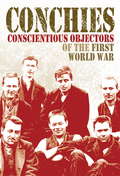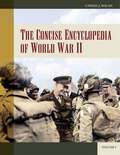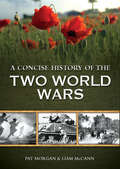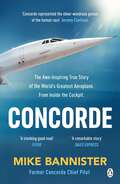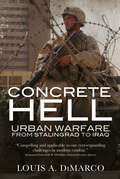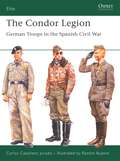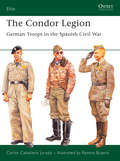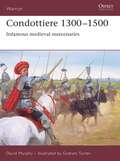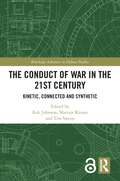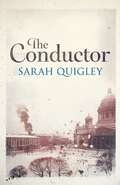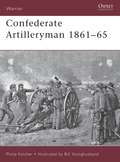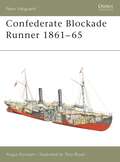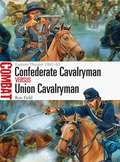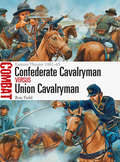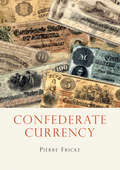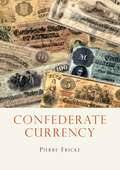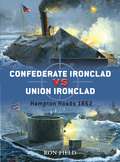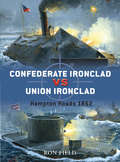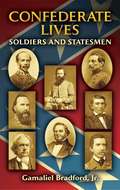- Table View
- List View
Conchies: Conscientious Objectors Of The First World War (One Shot Ser.)
by Ann KramerWhen, at the height of the First World War, many Allied governments introduced conscription, there were thousands of individuals who, for personal or religious reasons, refused to fight. After tough questioning, some were exempted but the majority were forced into the army anyways. Those who 'refused to do their duty' were threatened with death sentences or harsh prison terms; many died from ill treatment. Conchies collects many of the moving true stories of these brave individuals.
The Concise Encyclopedia of World War II [2 volumes]: [2 volumes]
by Cathal J. NolanA comprehensive and integrated military, political, and strategic history of World War II, ranging from the daily life of conscripts and civilians to operational and strategic decision making at the highest levels.Filled with up-to-date scholarship yet supremely manageable and accessible, The Concise Encyclopedia of World War II offers the opportunity to explore a conflict that remains a source of fascination for scholars, students, and general readers alike.From the battlefields to the corridors of power, from the barracks to the home front, The Concise Encyclopedia of World War II provides a complete portrait of the war. Entries not only address major battles and campaigns, but political, economic, and cultural issues as well, plus brief portraits of the conflict's commanding personalities. Its global perspective notably corrects the usual Western focus of World War II studies, incorporating a wealth of information on often underreported topics such as the Eastern Front and the Sino-Japanese War.
A Concise History of Two World Wars
by Pat Morgan Liam McCannThis new ebook combines both concise histories of WWI and WWII in one book, written by Pat Morgan and Liam McCann respectively.WWIOn 28 June 1914 in Sarajevo, a Bosnian Serb student shot the heir to the throne of the Austro-Hungarian Empire. The assassination plunged the world into a global conflict that was to scar human history and redefine the meaning of the word ‘war’.The assassination of Archduke Franz Ferdinand provided the spark that ignited smouldering enmities, but World War I had been a long time coming. Decades of burgeoning imperialism and the formation of complex alliances brought the world’s great powers face to face in what would become known as the Great War.On one side were ranged the Allies of Great Britain, France and Russia; on the other the Central Powers of Germany and Austria-Hungary. As time went on and the killing continued, all the world’s powers were drawn into battle and the war’s deadly influence touched every corner of the planet.More than seventy million military personnel were mobilised during World War I – and more than nine million of them died. The grim figures also included twenty million wounded and eight million missing in action.When the war ended in 1918, four empires had ceased to exist, the map of Europe had been redrawn and a generation of young men had been lost. The combatants had given their all, but their valiant sacrifice was in vain. This book tells the story of the conflict dubbed ‘the war to end wars’.WWIIBy 1938 a second war in Europe seemed inevitable. It had only been twenty years since the war to end all wars, and the horrors of conflict were still fresh in the mind, but that didn’t stop all sides re-arming and preparing for yet more bloodshed.The settlement at the end of World War One was neither clean nor decisive, and it punished Germany by confiscating territory and forcing the people to pay reparations to help rebuild France and reduce the Allied debt to America. This led to deep-seated anger and resentment among its people.This erudite and moving book explores the underlying causes of the Second World War, its biggest battles and decisive campaigns. From the evacuation at Dunkirk, the Blitz and the Battle of Britain to the failure of Operation Barbarossa and the D-Day Landings in Europe, as well as the war in North Africa and the Pacific, this concise history of the conflict also examines the Final Solution and the ethics surrounding the dropping of two atom bombs on Japan.
Concorde: The thrilling account of history’s most extraordinary airliner
by Mike BannisterThe definitive account of the rise and fall of the iconic Concorde plane from British Airways' former Chief Concorde Pilot'A remarkable story' DAILY EXPRESS'A stonking good read' FLYER_________What's it like to fly faster than a bullet?Could you really glimpse the edge of space?Why will we never see Concorde's like again?Mike Bannister was British Airways' Chief Concorde Pilot. One of the few in that legendary aircraft's quarter-century of flight to fully understand both the plane's intricate engineering and what it took to fly her at supersonic speeds.In this definitive account of the rise and fall of the world's greatest aircraft, Bannister explores its origins, development, service, highs, lows and, finally, the terrible crash which ended its flying life.Part celebration, part history, part detective story and part courtroom drama, it's almost as riveting as flying in Concorde itself - almost . . ._________'Concorde represented the sheer wondrous genius of the human race' JEREMY CLARKSON
Concrete Hell: Urban Warfare From Stalingrad to Iraq
by Louis A. DiMarcoThroughout history cities have been at the center of warfare, from sieges to street-fighting, from peace-keeping to coups de mains. Sun Tzu admonished his readers of The Art of War that the lowest realization of warfare was to attack a fortified city. Indeed, although strategists have advised against it across the millennia, armies and generals have been forced nonetheless to attack and defend cities, and victory has required that they do it well. In Concrete Hell Louis DiMarco has provided a masterful study of the brutal realities of urban warfare, of what it means to seize and hold a city literally block by block. Such a study could not be more timely. We live in an increasingly urbanizing world, a military unprepared for urban operations is unprepared for tomorrow. Di Marco masterfully studies the successes and failures of past battles in order to provide lessons for today's tacticians.
Concrete Hell: Urban Warfare From Stalingrad to Iraq (General Military Ser.)
by Louis A. DiMarcoThroughout history cities have been at the center of warfare, from sieges to street-fighting, from peace-keeping to coups de mains. Sun Tzu admonished his readers of The Art of War that the lowest realization of warfare was to attack a fortified city. Indeed, although strategists have advised against it across the millennia, armies and generals have been forced nonetheless to attack and defend cities, and victory has required that they do it well. In Concrete Hell Louis DiMarco has provided a masterful study of the brutal realities of urban warfare, of what it means to seize and hold a city literally block by block. Such a study could not be more timely. We live in an increasingly urbanizing world, a military unprepared for urban operations is unprepared for tomorrow. Di Marco masterfully studies the successes and failures of past battles in order to provide lessons for today's tacticians.
The Condor Legion: German Troops in the Spanish Civil War (Elite #131)
by Ramiro Bujeiro Carlos Caballero JuradoThe Condor Legion was the expeditionary force of soldiers and airmen sent by Hitler to aid Franco's Nationalists in the Spanish Civil War. The Germans used the war as an opportunity to develop equipment and tactics, and their force included not only instructors, but also combat units of artillery, tanks and aircraft. These units tested guns, tanks and planes and perfected techniques which were used in the 1940 Blitzkrieg. Many of officers prominent in the early campaigns of World War II won their first successes in Spain. This book details the Legion and its unique uniform and insignia.
The Condor Legion: German Troops in the Spanish Civil War (Elite #131)
by Ramiro Bujeiro Carlos Caballero JuradoThe Condor Legion was the expeditionary force of soldiers and airmen sent by Hitler to aid Franco's Nationalists in the Spanish Civil War. The Germans used the war as an opportunity to develop equipment and tactics, and their force included not only instructors, but also combat units of artillery, tanks and aircraft. These units tested guns, tanks and planes and perfected techniques which were used in the 1940 Blitzkrieg. Many of officers prominent in the early campaigns of World War II won their first successes in Spain. This book details the Legion and its unique uniform and insignia.
Condottiere 1300–1500: Infamous medieval mercenaries (Warrior)
by David MurphyOriginally contracted by wealthy Italian city states to protect their assets during a time of ceaseless warring, many condottieri of the Italian peninsula became famous for their wealth, venality and amorality during the 14th and 15th centuries. Some even came to rule cities themselves. Lavishly illustrated with contemporary depictions and original artwork, this title examines the complex military organization, recruitment, training and weaponry of the Condottieri. With insight into their origins and motivations, the author, Dr David Murphy, brings together the social, political and military history of these powerful and unscrupulous men who managed to influence Italian society and warfare for over two centuries.
Condottiere 1300–1500: Infamous medieval mercenaries (Warrior)
by David MurphyOriginally contracted by wealthy Italian city states to protect their assets during a time of ceaseless warring, many condottieri of the Italian peninsula became famous for their wealth, venality and amorality during the 14th and 15th centuries. Some even came to rule cities themselves. Lavishly illustrated with contemporary depictions and original artwork, this title examines the complex military organization, recruitment, training and weaponry of the Condottieri. With insight into their origins and motivations, the author, Dr David Murphy, brings together the social, political and military history of these powerful and unscrupulous men who managed to influence Italian society and warfare for over two centuries.
The Conduct of War in the 21st Century: Kinetic, Connected and Synthetic (Routledge Advances in Defence Studies)
by Rob Johnson Tim Sweijs Martijn KitzenThis book examines the key dimensions of 21st century war, and shows that orthodox thinking about war, particularly what it is and how it is fought, needs to be updated. Accelerating societal, economic, political and technological change affects how we prepare, equip and organise for war, as well as how we conduct war – both in its low-tech and high-tech forms, and whether it is with high intensity or low intensity. The volume examines changes in warfare by investigating the key features of the conduct of war during the first decades of the 21st century. Conceptually centred around the terms ‘kinetic’, ‘connected’ and ‘synthetic’, the analysis delves into a wide range of topics. The contributions discuss hybrid warfare, cyber and influence activities, machine learning and artificial intelligence, the use of armed drones and air power, the implications of the counterinsurgency experiences in Iraq, Afghanistan and Syria, as well as the consequences for law(fare) and decision making. This work will be of much interest to students of military and strategic studies, security studies and International Relations.
The Conduct of War in the 21st Century: Kinetic, Connected and Synthetic (Routledge Advances in Defence Studies)
by Rob Johnson, Martijn Kitzen and Tim SweijsThis book examines the key dimensions of 21st century war, and shows that orthodox thinking about war, particularly what it is and how it is fought, needs to be updated. Accelerating societal, economic, political and technological change affects how we prepare, equip and organise for war, as well as how we conduct war – both in its low-tech and high-tech forms, and whether it is with high intensity or low intensity. The volume examines changes in warfare by investigating the key features of the conduct of war during the first decades of the 21st century. Conceptually centred around the terms ‘kinetic’, ‘connected’ and ‘synthetic’, the analysis delves into a wide range of topics. The contributions discuss hybrid warfare, cyber and influence activities, machine learning and artificial intelligence, the use of armed drones and air power, the implications of the counterinsurgency experiences in Iraq, Afghanistan and Syria, as well as the consequences for law(fare) and decision making. This work will be of much interest to students of military and strategic studies, security studies and International Relations.
The Conductor
by Sarah QuigleyThe Conductor reads like a proper up-all-night page-turner, but it also goes deeper than that, conveying the extraordinary life-saving properties of music, and hope' – Bella Bathurst.The story of how Shostakovich and one valiant orchestra created a defining moment in the siege of Leningrad is a gripping testament to the life saving power of music. June 1941: Nazi troops surround the city of Leningrad, planning to shell and starve the people into submission. Most of the cultural elite is evacuated, but the famous composer Shostakovich stays behind to defend his city. That winter, the bleakest in Russian history, the Party orders Karl Eliasberg, the shy, difficult conductor of a second-rate orchestra, to prepare for the task of a lifetime. He is to conduct a performance of Shostakovich's Seventh Symphony – a haunting, defiant new piece, which will be relayed by loudspeakers to the front lines. Eliasberg's musicians are starving, and scarcely have the strength to carry their instruments. But for five freezing months the conductor stubbornly drives on his musicians, depriving those who falter of their bread rations. Slowly the music begins to dissolve the nagging hunger, the exploding streets, the slow deaths... but at what cost? Eliasberg's relationships are strained, obsession takes hold, and his orchestra is growing weaker. Now, it's a struggle not just to perform but to stay alive.
Confederate Artilleryman 1861–65 (Warrior)
by Bill Younghusband Philip KatcherIn the heady days of the rush to arms in 1861, comparatively few Southern men volunteered for service in the artillery: most preferred the easily accessible glory of the infantry or cavalry. Yet those that did quickly earned the respect of their fellow soldiers, and a reputation for being able to "pull through deeper mud, ford deeper springs, shoot faster, swear louder ... than any other class of men in the service". Given that field artillery was invariably deployed in front of the troops that it was supporting, the artillerymen were exposed to a high level of enemy fire, and losses were significant. This title guides the reader through the life and experiences of the Confederate cannoneer where he came from; how he trained and lived; how he dressed, ate and was equipped; and how he fought.
Confederate Artilleryman 1861–65 (Warrior #34)
by Bill Younghusband Philip KatcherIn the heady days of the rush to arms in 1861, comparatively few Southern men volunteered for service in the artillery: most preferred the easily accessible glory of the infantry or cavalry. Yet those that did quickly earned the respect of their fellow soldiers, and a reputation for being able to "pull through deeper mud, ford deeper springs, shoot faster, swear louder ... than any other class of men in the service". Given that field artillery was invariably deployed in front of the troops that it was supporting, the artillerymen were exposed to a high level of enemy fire, and losses were significant. This title guides the reader through the life and experiences of the Confederate cannoneer where he came from; how he trained and lived; how he dressed, ate and was equipped; and how he fought.
The Confederate Battle Flag: America's Most Embattled Emblem
by John M. CoskiIn recent years, the Confederate flag has become as much a news item as a Civil War relic. Intense public debates have erupted over Confederate flags flying atop state capitols, being incorporated into state flags, waving from dormitory windows, or adorning the T-shirts and jeans of public school children. To some, this piece of cloth is a symbol of white supremacy and enduring racial injustice; to others, it represents a rich Southern heritage and an essential link to a glorious past. Polarizing Americans, these "flag wars" reveal the profound--and still unhealed--schisms that have plagued the country since the Civil War. The Confederate Battle Flag is the first comprehensive history of this contested symbol. Transcending conventional partisanship, John Coski reveals the flag's origins as one of many banners unfurled on the battlefields of the Civil War. He shows how it emerged as the preeminent representation of the Confederacy and was transformed into a cultural icon from Reconstruction on, becoming an aggressively racist symbol only after World War II and during the Civil Rights movement. We gain unique insight into the fine line between the flag's use as a historical emblem and as an invocation of the Confederate nation and all it stood for. Pursuing the flag's conflicting meanings, Coski suggests how this provocative artifact, which has been viewed with pride, fear, anger, nostalgia, and disgust, might ultimately provide Americans with the common ground of a shared and complex history.
Confederate Blockade Runner 1861–65 (New Vanguard)
by Angus KonstamThe lifeblood of the Confederacy, the blockade runners of the Civil War usually began life as regular fast steam-powered merchant ships. They were adapted for the high-speed dashes through the Union blockade which closed off all the major Southern ports, and for much of the war they brought much-needed food, clothing and weaponry to the Confederacy. This book traces their operational history, including the development of purpose-built blockade running ships, and examines their engines, crews and tactics. It describes their wartime exploits, demonstrating their operational and mechanical performance, whilst examining what life was like on these vessels through accounts of conditions on board when they sailed into action.
Confederate Blockade Runner 1861–65 (New Vanguard)
by Angus KonstamThe lifeblood of the Confederacy, the blockade runners of the Civil War usually began life as regular fast steam-powered merchant ships. They were adapted for the high-speed dashes through the Union blockade which closed off all the major Southern ports, and for much of the war they brought much-needed food, clothing and weaponry to the Confederacy. This book traces their operational history, including the development of purpose-built blockade running ships, and examines their engines, crews and tactics. It describes their wartime exploits, demonstrating their operational and mechanical performance, whilst examining what life was like on these vessels through accounts of conditions on board when they sailed into action.
Confederate Cavalryman vs Union Cavalryman: Eastern Theater 1861–65 (Combat)
by Peter Dennis Ron FieldDuring the intense, sprawling conflict that was the American Civil War, both Union and Confederate forces fielded substantial numbers of cavalry, which carried out the crucial tasks of reconnaissance, raiding, and conveying messages. The perception was that cavalry's effectiveness on the battlefield would be drastically reduced in this age of improved infantry firearms. This title, however, demonstrates how cavalry's lethal combination of mobility and dismounted firepower meant it was still very much a force to be reckoned with in battle, and charts the swing in the qualitative difference of the cavalry forces fielded by the two sides as the war progressed. In this book, three fierce cavalry actions of the American Civil War are assessed, including the battles of Second Bull Run/Manassas (1862), Buckland Mills (1863) and Tom's Brook (1864).
Confederate Cavalryman vs Union Cavalryman: Eastern Theater 1861–65 (Combat)
by Peter Dennis Ron FieldDuring the intense, sprawling conflict that was the American Civil War, both Union and Confederate forces fielded substantial numbers of cavalry, which carried out the crucial tasks of reconnaissance, raiding, and conveying messages. The perception was that cavalry's effectiveness on the battlefield would be drastically reduced in this age of improved infantry firearms. This title, however, demonstrates how cavalry's lethal combination of mobility and dismounted firepower meant it was still very much a force to be reckoned with in battle, and charts the swing in the qualitative difference of the cavalry forces fielded by the two sides as the war progressed. In this book, three fierce cavalry actions of the American Civil War are assessed, including the battles of Second Bull Run/Manassas (1862), Buckland Mills (1863) and Tom's Brook (1864).
Confederate Currency (Shire Library USA #655)
by Pierre FrickeOn February 4, 1861, the Confederate States of America was formed, and almost immediately the first Confederate notes were printed – the famous "Montgomery†? notes. These would be followed by many designs over the next four years. The seventy different designs or "type†? notes are eagerly sought today by collectors, historians and family historians, and a collection of Confederate currency offers fascinating insights into the tumultuous Civil-War period. Pierre Fricke examines these series of Confederate notes, highlighting the history and circumstances in which they were created. This easy-to-read, fun and educational book offers an introduction to the often beautiful notes that financed the Confederacy.
Confederate Currency (Shire Library USA)
by Pierre FrickeOn February 4, 1861, the Confederate States of America was formed, and almost immediately the first Confederate notes were printed – the famous "Montgomery†? notes. These would be followed by many designs over the next four years. The seventy different designs or "type†? notes are eagerly sought today by collectors, historians and family historians, and a collection of Confederate currency offers fascinating insights into the tumultuous Civil-War period. Pierre Fricke examines these series of Confederate notes, highlighting the history and circumstances in which they were created. This easy-to-read, fun and educational book offers an introduction to the often beautiful notes that financed the Confederacy.
Confederate Ironclad vs Union Ironclad: Hampton Roads 1862 (Duel)
by Howard Gerrard Peter Bull Ron FieldThe Ironclad was a revolutionary weapon of war, the first modern, armoured, self-propelled warships. During the American Civil War the South used ironclads to protect their ports from the Northern blockade. Impressed with their superior resistance to fire and, the North developed its own rival fleet of ironclads. Eventually the two products of this modern arms race duelled at the battle of Hampton Roads in a clash that would change the face of naval warfare. Fully illustrated with cutting-edge digital artwork, rare photographs and first-person perspective gunsight views, this book allows the reader to discover the revolutionary and radically different designs of the two rival Ironclads – the Merrimac and USS Monitor – through an analysis of each ship's weaponry, ammunition and steerage.
Confederate Ironclad vs Union Ironclad: Hampton Roads 1862 (Duel #14)
by Howard Gerrard Peter Bull Ron FieldALSO AVAILABLE TO BUY AS AN E-BOOK. The Ironclad was a revolutionary weapon of war, the first modern, armoured, self-propelled warships. During the American Civil War the South used ironclads to protect their ports from the Northern blockade. Impressed with their superior resistance to fire and, the North developed its own rival fleet of ironclads. Eventually the two products of this modern arms race duelled at the battle of Hampton Roads in a clash that would change the face of naval warfare. Fully illustrated with cutting-edge digital artwork, rare photographs and first-person perspective gunsight views, this book allows the reader to discover the revolutionary and radically different designs of the two rival Ironclads – the Merrimac and USS Monitor – through an analysis of each ship's weaponry, ammunition and steerage.
Confederate Lives: Soldiers and Statesmen (Civil War)
by Gamaliel BradfordThe distinguished historian Gamaliel Bradford, Jr.--author of Lee, the American and other acclaimed Civil War biographies--offers portraits of eight key leaders of the Confederacy. Bradford's skills at compiling concise profiles are at their finest in these compelling sketches of prominent figures in the Southern Cause.Commanding officers include Joseph E. Johnston, the highest-ranking U.S. Army officer to resign and join the Confederacy; the war's most famous cavalryman, J. E. B. Stuart; Lee's "Old War Horse," James Longstreet, who served from Manassas to Appomattox; P. G. T. Beauregard, winner of the nearly bloodless victory at Fort Sumter; and Rear Admiral Raphael Semmes, so successful in battle that he was charged at the war's end with treason and piracy. Confederate statesmen include U.S. Senator Judah P. Benjamin, appointed by Jefferson Davis as Confederate attorney general, secretary of war, and secretary of state; Vice-President of the Confederate States, Alexander H. Stephens; and Senator Robert Toombs, who evolved from conservative Unionist to ardent secessionist.The book concludes with the "high water mark" of the Confederacy at Gettysburg and examines the effects of that momentous battle. Previously available only in expensive, hard-to-find editions, this volume is a rare find for Civil War buffs.
